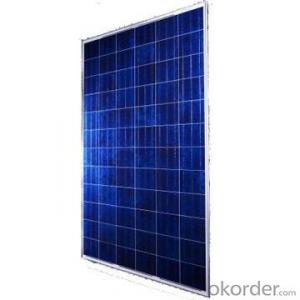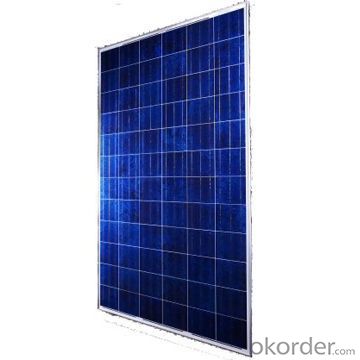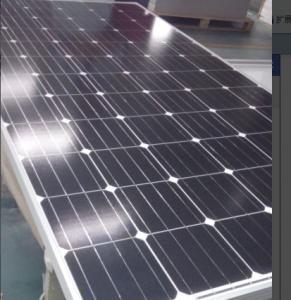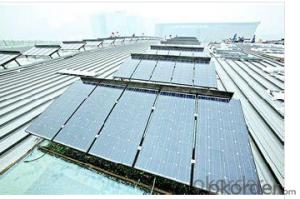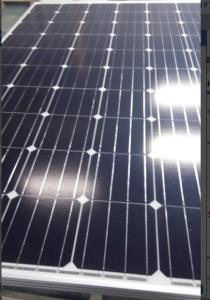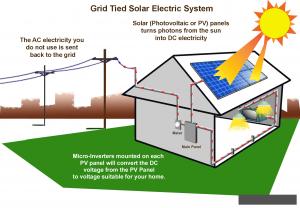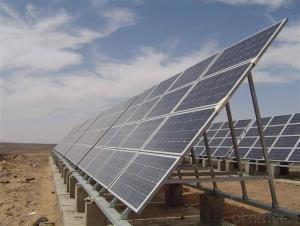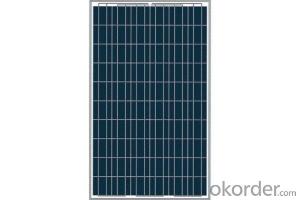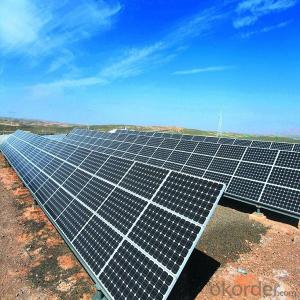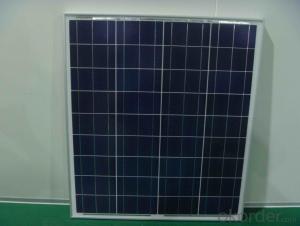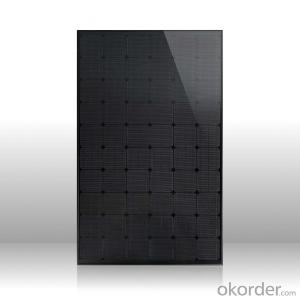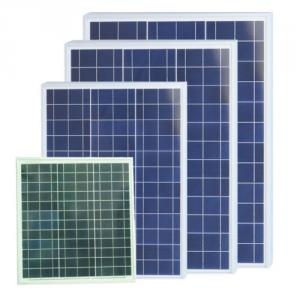Solar Panels Wyoming - 2024 150w Off-Grid Polycrystalline Solar Panel with High Efficiency
- Loading Port:
- Tianjin
- Payment Terms:
- TT OR LC
- Min Order Qty:
- 1000 watt
- Supply Capability:
- 10000000 watt/month
OKorder Service Pledge
OKorder Financial Service
You Might Also Like
Specification
Product Description
Key Specifications/Special Features
Maximum power: 150Wp
Maximum working voltage: 17.3V
Maximum working current: 8.67A
Open circuit voltage: 42.84V
Short-circuit current: 21.6A
Battery efficiency: 15%
Cell number: 72pcs (6 x 12mm)
Cell dimensions: 125 x 125mm
Solar panel dimensions: 670*1480*35mm
Maximum system voltage: 1,000V
Operating temperature: -40 to 85°C
Surface maximum loading capacity: (surface can withstand the maximum pressure) 60m/s (200kg/sq.m)
Allowable hail load (hail stress testing) steel ball fall down from 1m height
Weight of each solar panel: 16kg
Connection box type: PV-JB001 (TUV)
Cable type: with TUV mark
Cable length: 900mm ,also can according the customer's requirement to product
Output power tolerance: ± 3%
Frame material: aluminum
Standard test conditions (STC): 1,000W/m² AM1.525°C
10 years product warranty and 25 years 80% of power
Fill factor: e 72%
20-foot container quantity: 37pcs
40-foot container quantity: 700pcs
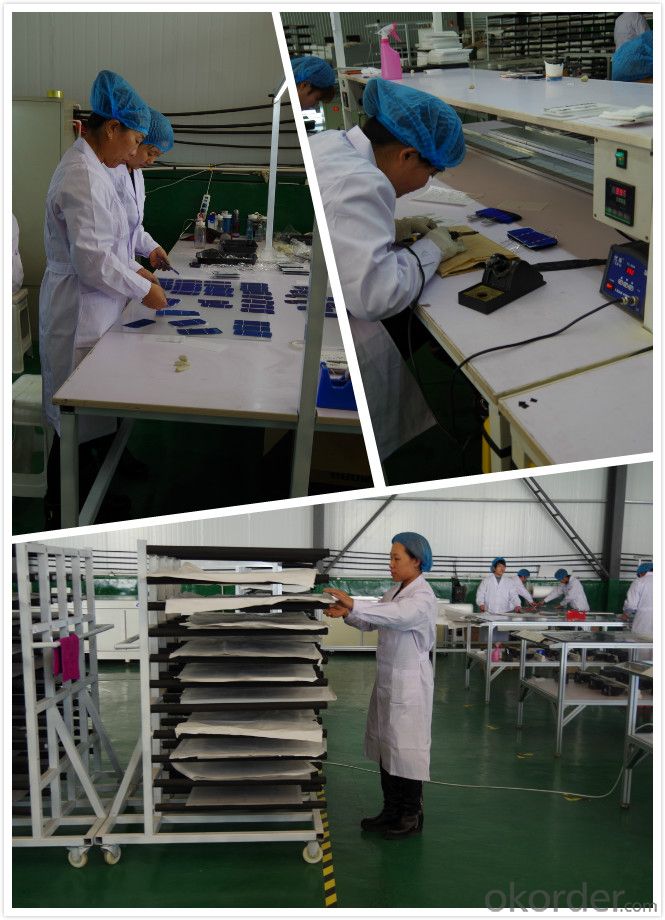
| Cell type | Poly-crystalline silicon solar cell |
| Size | 6780*480*35mm |
| Weight | 14.3 kg |
| Solar cell type | 156*156 mm |
| Number of cell (pcs) | 4*9 PCS |
| Maximum Power | 150 Wp |
| Mctual measurement results | 86.4 Wp |
| Optimum operating voltage | 17.3 V |
| Optimum operating current | 8.67 A |
| Open ciruit voltage | 21.6V |
| Short circuit current | 9.69 A |
| Power Tolerance | 1%-3% |
| Backing | TPT |
| Tempering glass thickness | 3.2 mm |
| Frame Material | Clear anodized aluminium frame |
| Operating temperature | -40 C+85 C |
| Storage temperature | from-40 C~+85 C |
| Maximum wind resistance | 60m/s |
| Surface maximum load capacity | 200Kg/M2 |
| Maximum hail load capacity | 25mm, 80km/h |
| Efficiency of panel | 14.50% |
Other Modules:
| Electrical Data | Module Size | Weight | Number of cells series | ||||
| Nominal Pwer | Max-Power | Max-Power | Open-Circuit | Short-Circuit | |||
| Voltage | Current | Voltage | Current | ||||
| Pmax | VMPP | IMPP | VOC | ISC | |||
| W | V | A | V | A | mm | Kg | pc |
| 10 | 17.2 | 0.58 | 21.6 | 1.31 | 340*254*17 | 1.2 | 36 |
| 20 | 17.2 | 1.16 | 21.6 | 1.93 | 340*460*25 | 1.8 | 36 |
| 30 | 17.3 | 1.73 | 21.6 | 1.83 | 350*670*30 | 3 | 36 |
| 40 | 17.3 | 2.13 | 21.6 | 2.45 | 460*670*30 | 3.5 | 36 |
| 50 | 17.3 | 2.89 | 21.6 | 3.06 | 560*670*30 | 4.5 | 36 |
| 60 | 17.3 | 3.47 | 21.6 | 3.68 | 670*670*30 | 5.3 | 36 |
| 70 | 17.2 | 4.05 | 21.6 | 4.29 | 758*670*30 | 6 | 36 |
| 80 | 17.3 | 4.62 | 21.6 | 4.90 | 758*670*30 | 6.5 | 36 |
| 90 | 17.2 | 5.23 | 21.6 | 5.81 | 935*670*30 | 6.7 | 36 |
| 100 | 17.2 | 5.8 | 21.6 | 6.46 | 935*670*30 | 6.7 | 36 |
| 110 | 17.2 | 6.4 | 21.6 | 7.08 | 1061*670*35 | 8 | 36 |
| 120 | 17.2 | 6.98 | 21.6 | 7.72 | 1161*670*35 | 8.6 | 36 |
| 130 | 17.2 | 7.56 | 21.6 | 8.4 | 1277*670*35 | 9.8 | 36 |
| 140 | 17.2 | 4 | 21.6 | 4.4 | 1480*670*35 | 10.9 | 36 |
| 150 | 17.2 | 4.17 | 21.6 | 4.58 | 1480*670*35 | 10.9 | 36 |
| 160 | 34.4 | 4.65 | 43.2 | 5.17 | 1480*670*35 | 10.9 | 72 |
| 170 | 34.4 | 4.94 | 43.2 | 5.49 | 1172*983*35 | 11.7 | 72 |
| 180 | 34.4 | 5.23 | 43.2 | 5.81 | 1172*983*35 | 11.7 | 72 |
| 190 | 34.4 | 5.52 | 43.2 | 6.14 | 1260*983*35 | 14.6 | 72 |
| 200 | 34.4 | 5.81 | 43.2 | 6.5 | 1260*983*35 | 14.6 | 72 |
| 210 | 34.4 | 6.1 | 43.2 | 6.85 | 1488*983*35 | 14.6 | 72 |
| 220 | 34.4 | 6.4 | 43.2 | 7.08 | 1488*983*35 | 15.2 | 72 |
- Q: what do I need to do to disconnect a solar panel from a battery to protect the panel?
- Know that solar panels almost always incorporate a blocking diode to prevent a battery from back-feeding through an un-illuminated panel. Know that solar panels are usually connected to a battery via an electronic switching charge controller, not directly connected. Know that when a solar panel is open-circuited (disconnected from everything) it's terminal voltage will rise to almost twice it's nominal voltage. (22V is common for a 2V panel), unless it is stored in total darkness.
- Q: Hello, I am shopping for solar panels for my home and there are so many to choose from. My house uses 40 Kw of power a day. If you had to choose from the output power of a solar panel from below, which one would you choose and why would you choose it? 2 Volts 4 Amps 48Watts2 Volts 8.5 Amps 02Watts6 Volts 7 Amps 2Watts24 Volts 4.2 Amps 00.8Watts24 Volts 8 Amps 95Watts
- the last one has highest wattage. that will bring down the total number of panels you need to meet 40 KW. you probably need 220 panels
- Q: Pretty much, can solar panel's support the entire houses electrical needs generally, because I know sometimes the owner's can sell unused electricity back, any ideas or any ideas on how much the average home uses in kWh
- Solar okorder
- Q: I have a cabin in the woods and need more light. I do have enough sun but I was wondering how or where do I get a solar panel to lead to a power outlet? In a perfect world I would like to get a solar panel with a connecting wire to an outlet or something so I could power a small TV. I know its hard enough but can I get that pre-made? Or even lastly should I look at wind power consider I would like this to be under $500? Thank you for putting up with this bundle of questions.
- First okorder /
- Q: How much energy can a solar panel produce in a day?
- The amount of energy a solar panel can produce in a day depends on various factors such as the size and efficiency of the panel, the location and angle of installation, weather conditions, and sunlight availability. On average, a typical solar panel can generate between 4 to 6 kilowatt-hours (kWh) of electricity per day. However, this can vary significantly, and larger, more efficient panels in optimal conditions can produce even more energy.
- Q: Can solar panels be used to power streetlights or outdoor lighting?
- Yes, solar panels can be used to power streetlights or outdoor lighting. Solar panels convert sunlight into electricity, which can be stored in batteries and used to power streetlights or outdoor lighting fixtures during nighttime. This helps to reduce reliance on traditional grid-based electricity and promotes more sustainable and environmentally friendly lighting solutions.
- Q: Can solar panels be installed on a pole or ground mount?
- Yes, solar panels can be installed on both poles and ground mounts. Pole mounts are often used when there is limited space on the ground or when panels need to be elevated for better sunlight exposure. Ground mounts, on the other hand, are ideal for larger installations or when the ground is more suitable for anchoring. Both options offer flexibility in terms of placement and can effectively harness solar energy.
- Q: how does solar panels work?
- Solar panels collect solar radiation from the sun and actively convert that energy to electricity. Solar panels are comprised of several individual solar cells. These solar cells function similarly to large semiconductors and utilize a large-area p-n junction diode. When the solar cells are exposed to sunlight, the p-n junction diodes convert the energy from sunlight into usable electrical energy. The energy generated from photons striking the surface of the solar panel allows electrons to be knocked out of their orbits and released, and electric fields in the solar cells pull these free electrons in a directional current, from which metal contacts in the solar cell can generate electricity. The more solar cells in a solar panel and the higher the quality of the solar cells, the more total electrical output the solar panel can produce. The conversion of sunlight to usable electrical energy has been dubbed the Photovoltaic Effect. The photovoltaic effect arises from the properties of the p-n junction diode, as such there are no moving parts in a solar panel.
- Q: Can solar panels be installed on a pergola or awning?
- Yes, solar panels can be installed on a pergola or awning. In fact, they can be a great option for maximizing solar energy production while providing shade and protection from the elements.
- Q: Can solar panels be installed on tile roofs?
- Yes, solar panels can be installed on tile roofs. Specialized mounting systems are designed to secure the panels to the tile roof without damaging it, ensuring a safe and efficient installation.
Send your message to us
Solar Panels Wyoming - 2024 150w Off-Grid Polycrystalline Solar Panel with High Efficiency
- Loading Port:
- Tianjin
- Payment Terms:
- TT OR LC
- Min Order Qty:
- 1000 watt
- Supply Capability:
- 10000000 watt/month
OKorder Service Pledge
OKorder Financial Service
Similar products
Hot products
Hot Searches
Related keywords
